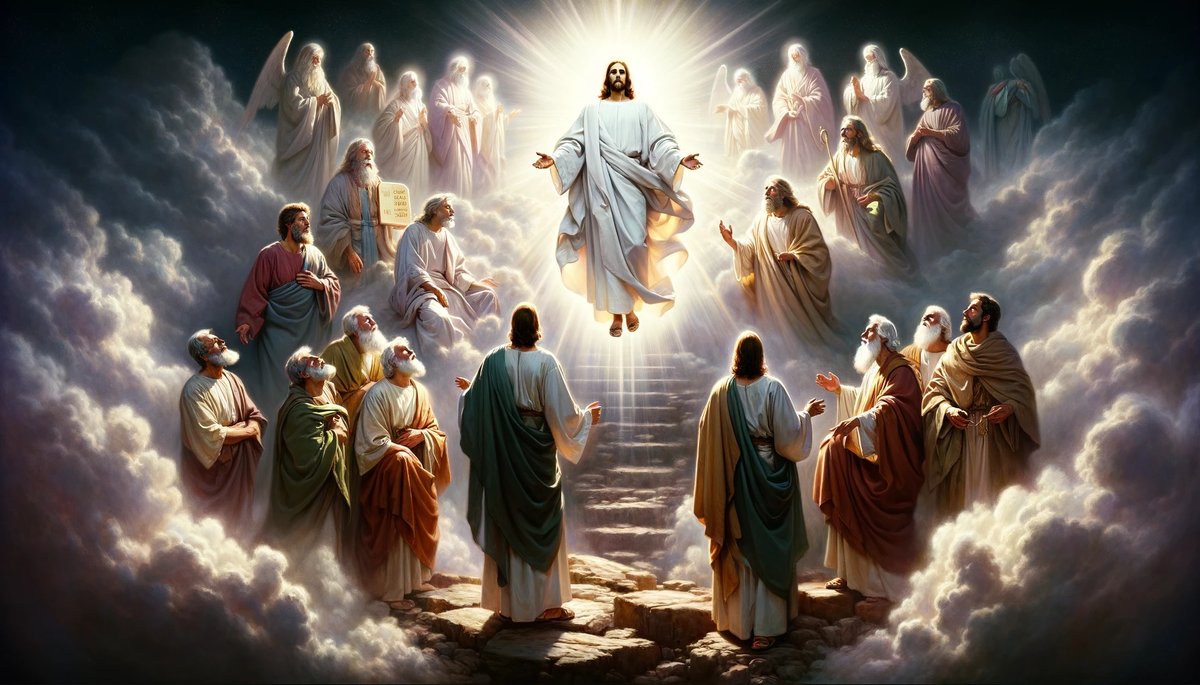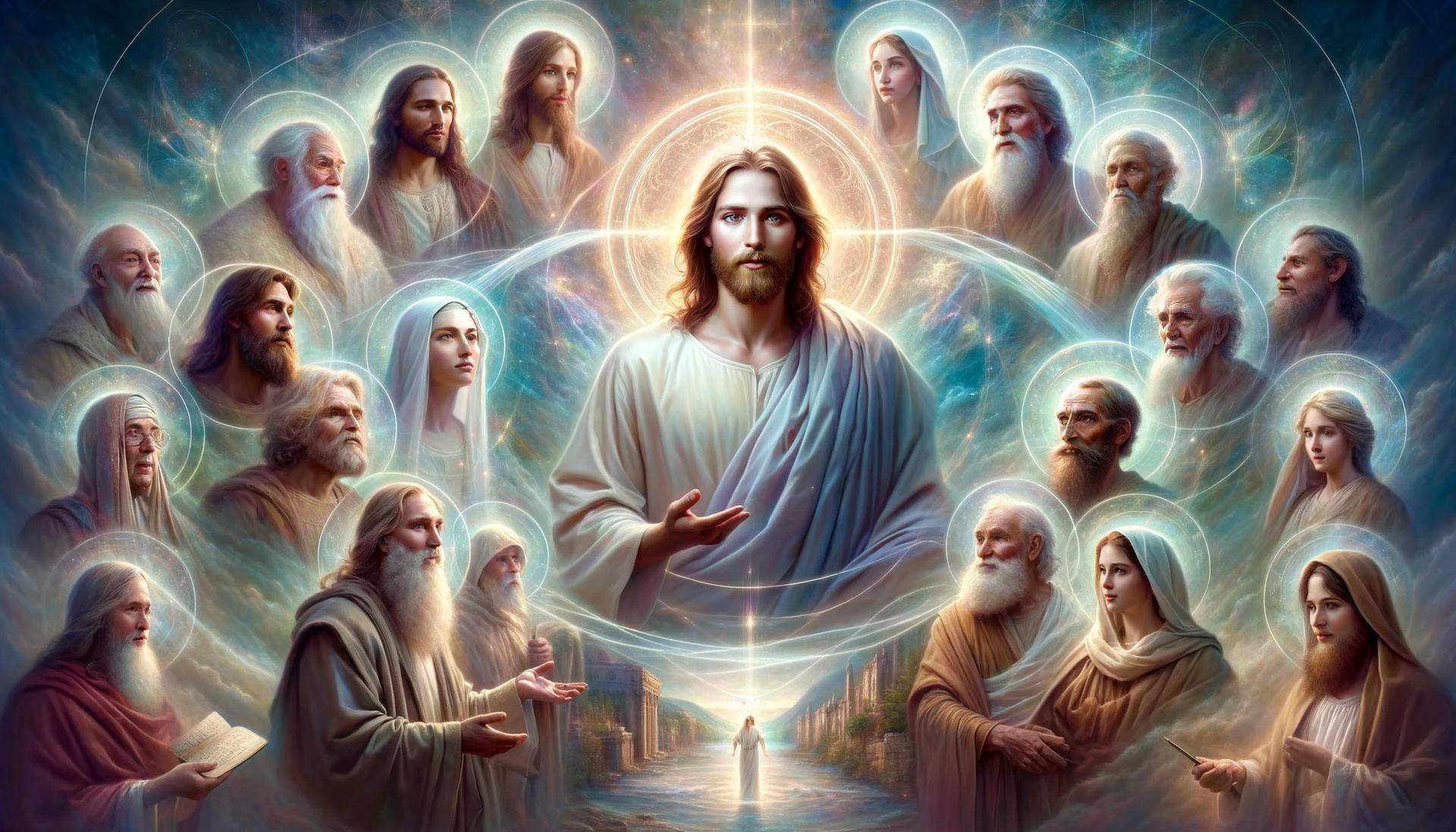Home>Christian Videos>Bible Stories>What Are The Miracles Of Jesus Christ


Bible Stories
What Are The Miracles Of Jesus Christ
Published: February 29, 2024
Ericka Andersen, an editor at Christian.net, expertly merges digital strategy with content creation, focusing on faith and societal issues. Her communication skills enhance the platform's engaging narratives, fostering meaningful dialogue on belief's impact on society.
Discover the awe-inspiring miracles of Jesus Christ in the Bible stories. Explore the divine wonders and teachings of the Son of God. Uncover the power of faith and compassion.
(Many of the links in this article redirect to a specific reviewed product. Your purchase of these products through affiliate links helps to generate commission for Christian.net, at no extra cost. Learn more)
Table of Contents
Introduction
The miracles of Jesus Christ are a central aspect of Christian belief and are recorded in the New Testament of the Bible. These miracles are extraordinary events that are said to have been performed by Jesus during his time on Earth. They serve as a demonstration of his divine nature and power, and they are an essential part of the foundation of the Christian faith. In this article, we will explore some of the most well-known miracles attributed to Jesus and their significance in the Christian tradition. Let's delve into the extraordinary acts that have inspired and captivated believers for centuries.
Healing the Sick
-
The Healing of the Paralytic: One of the most famous instances of Jesus healing the sick is the story of the paralytic man. In this miracle, Jesus not only heals the man's physical ailment but also forgives his sins, demonstrating the interconnectedness of physical and spiritual healing in the Christian tradition.
-
The Healing of the Blind Man: Jesus is also said to have healed a man who was blind from birth. This miracle is significant not only for the restoration of the man's sight but also for the symbolism of spiritual blindness being lifted, allowing the man to see both physically and spiritually.
-
The Healing of the Woman with the Issue of Blood: Another powerful example of Jesus' healing miracles is the story of the woman who had been suffering from a hemorrhage for twelve years. She is said to have been instantly healed by touching the hem of Jesus' garment, demonstrating the power of faith and the accessibility of healing through Jesus.
-
The Healing of the Centurion's Servant: In this miracle, Jesus heals the servant of a Roman centurion without even being physically present. This demonstrates the far-reaching nature of Jesus' healing power and his willingness to heal all who come to him in faith, regardless of social or cultural barriers.
-
The Healing of the Leper: Jesus' healing of a man afflicted with leprosy is a powerful demonstration of his compassion and willingness to touch and heal those who were considered untouchable and unclean in society.
The healing miracles of Jesus are not only accounts of physical healing but also serve as symbols of the spiritual healing and restoration that Jesus offers to all who come to him in faith. These miracles are a testament to the compassionate and miraculous nature of Jesus Christ, and they continue to inspire and offer hope to believers around the world.
Feeding the Multitudes
-
Feeding the Five Thousand: One of the most well-known miracles of Jesus is the feeding of the five thousand. This miracle is recorded in all four Gospels and is a powerful demonstration of Jesus' ability to provide for the physical needs of a large crowd. With just five loaves of bread and two fish, Jesus multiplies the food to feed the entire multitude, with twelve baskets of leftovers remaining. This miracle not only showcases Jesus' divine power over the natural world but also serves as a symbol of his ability to satisfy the spiritual hunger of humanity.
-
Feeding the Four Thousand: In a similar miracle, Jesus feeds a crowd of four thousand people with seven loaves of bread and a few small fish. Once again, this act of multiplication highlights Jesus' ability to abundantly provide for the needs of those who come to him. The repetition of this miracle emphasizes the consistency of Jesus' compassion and provision, regardless of the size or composition of the crowd.
-
The Symbolism of Bread: The act of feeding the multitudes with bread holds deep symbolic significance in the Christian tradition. Jesus refers to himself as the "bread of life," and this miracle serves as a visual representation of his role in nourishing and sustaining the spiritual lives of believers. The abundance of food and the provision of leftovers convey the idea of Jesus' overflowing grace and the inexhaustible nature of his love and provision.
-
Lessons of Faith and Provision: The feeding of the multitudes also teaches important lessons about faith and provision. The disciples' initial doubt and concern about the lack of resources are met with Jesus' miraculous intervention, illustrating the need for unwavering faith in the face of scarcity. This miracle serves as a reminder that with Jesus, there is always an abundance, even in the midst of apparent scarcity.
-
The Eucharistic Connection: For many Christians, the feeding of the multitudes also holds a connection to the Eucharist, or Holy Communion, where bread and wine are shared as symbols of Christ's body and blood. The act of feeding the multitudes foreshadows the institution of the Eucharist, emphasizing the spiritual nourishment and sustenance that Jesus provides for his followers.
The miracles of feeding the multitudes are not only displays of Jesus' miraculous power but also carry deep spiritual and symbolic significance. They serve as reminders of Jesus' ability to abundantly provide for the physical and spiritual needs of humanity, and they continue to inspire faith and trust in his unwavering provision.
Walking on Water
-
The story of Jesus walking on water is one of the most iconic and awe-inspiring miracles in the New Testament. According to the Gospels, Jesus walked on the surface of the Sea of Galilee during a storm, approaching his disciples who were in a boat. This miraculous event is a powerful demonstration of Jesus' authority over the natural elements and his ability to defy the laws of physics.
-
Symbolism of Faith: The account of Jesus walking on water holds deep symbolism, particularly in relation to faith. When Peter, one of Jesus' disciples, expresses doubt and fear as he attempts to walk on water towards Jesus, he begins to sink. Jesus reaches out and saves him, emphasizing the importance of unwavering faith in the face of life's storms. This miracle serves as a reminder that with faith in Jesus, one can overcome seemingly impossible circumstances.
-
Mastery over Nature: The act of walking on water showcases Jesus' mastery over the natural world. By defying the limitations of human capability and the laws of gravity, Jesus demonstrates his divine authority and power. This miracle highlights the transcendence of Jesus beyond the physical realm and serves as a testament to his identity as the Son of God.
-
Comfort in Chaos: The context of the storm adds another layer of significance to this miracle. In the midst of a turbulent and frightening situation, Jesus' appearance brings comfort and reassurance to his disciples. This event serves as a metaphor for the presence of Jesus in the midst of life's storms, offering peace and stability even in the most tumultuous circumstances.
-
Spiritual Reflection: The story of Jesus walking on water invites believers to reflect on their own spiritual journey. Just as Peter experienced a moment of doubt and fear, this miracle encourages individuals to trust in Jesus and step out in faith, even when faced with daunting challenges. It serves as a reminder that with Jesus, there is always a firm foundation to stand upon, regardless of the uncertainties of life.
The miracle of Jesus walking on water is a profound testament to his divine nature and authority. It serves as a source of inspiration and encouragement for believers, reminding them of the power of faith and the unwavering presence of Jesus in the midst of life's storms.
Raising the Dead
-
Lazarus: The most well-known instance of Jesus raising the dead is the story of Lazarus. Lazarus, a close friend of Jesus, had been dead for four days when Jesus arrived at his tomb. Despite the skepticism of onlookers, Jesus called out to Lazarus, and he emerged from the tomb, alive once more. This extraordinary miracle not only demonstrated Jesus' power over death but also foreshadowed his own resurrection, offering a glimpse of the eternal life that he offers to believers.
-
The Widow's Son: Another instance of Jesus raising the dead is found in the account of the widow of Nain's son. As the funeral procession was underway, Jesus approached the young man's body, touched the coffin, and commanded him to arise. The young man sat up and began to speak, astonishing the crowd. This miracle not only brought joy and relief to the grieving mother but also served as a powerful testament to Jesus' authority over life and death.
-
Jairus' Daughter: Jesus also raised Jairus' daughter from the dead. Despite the mourners' laughter and disbelief, Jesus took the young girl by the hand and called her back to life. This act of compassion and miraculous restoration not only brought immense joy to the girl's family but also revealed Jesus' ability to bring hope and new life in the face of despair and loss.
-
Symbolism of Resurrection: The miracles of raising the dead hold deep symbolic significance in the Christian faith. They serve as powerful illustrations of the promise of resurrection and eternal life through Jesus Christ. These miracles offer hope to believers, assuring them that death is not the end and that through Jesus, there is the assurance of life beyond the grave.
-
Demonstration of Divine Power: The act of raising the dead is a profound demonstration of Jesus' divine power and authority. It showcases his ability to conquer the ultimate enemy, death, and offers a glimpse of the transformative and life-giving nature of his ministry. These miracles serve as a testament to the reality of Jesus' identity as the Son of God and the source of eternal life.
The miracles of raising the dead are not only extraordinary displays of Jesus' power but also carry deep spiritual significance. They offer reassurance to believers, affirming the promise of resurrection and eternal life through Jesus Christ.
Read more: What Was Jesus Christ’s Profession
Calming the Storm
-
The account of Jesus calming the storm is a powerful demonstration of his authority over the forces of nature. According to the Gospels, Jesus and his disciples were crossing the Sea of Galilee in a boat when a fierce storm arose, threatening to capsize the vessel. Despite the chaos and fear gripping the disciples, Jesus remained asleep in the boat. When his disciples woke him, fearing for their lives, Jesus rebuked the wind and the waves, instantly calming the storm and bringing about a great calm.
-
Symbolism of Chaos and Peace: The storm on the sea serves as a metaphor for the tumultuous and unpredictable nature of life. Jesus' ability to calm the storm not only showcases his power over the physical elements but also symbolizes his capacity to bring peace and tranquility to the storms of life. This miracle offers a profound message of hope and reassurance, reminding believers that even in the midst of life's most turbulent moments, Jesus has the power to bring about a great calm.
-
Faith and Trust: The disciples' reaction to the storm reflects the human tendency to be consumed by fear and doubt in the face of adversity. Jesus' response to their plea for help highlights the importance of unwavering faith and trust. This miracle serves as a reminder that with Jesus, there is always a source of strength and stability, even in the most daunting circumstances. It encourages believers to turn to Jesus in times of trouble, knowing that he has the power to bring peace to their lives.
-
Authority over Creation: The act of calming the storm demonstrates Jesus' authority over the natural world. By commanding the wind and the waves to be still, Jesus reveals his divine power and sovereignty. This miracle serves as a testament to Jesus' identity as the Son of God, with dominion over all creation. It reinforces the belief in Jesus as the ultimate source of peace and security, capable of bringing order to the chaos of the world.
-
Spiritual Reflection: The story of Jesus calming the storm invites believers to reflect on their own experiences of turmoil and uncertainty. It encourages them to place their trust in Jesus as the one who can bring calm to the storms of life. This miracle serves as a reminder that with Jesus, there is always a refuge from the storms that rage within and around us, offering a sense of peace that transcends earthly circumstances.
The miracle of Jesus calming the storm is a profound testament to his divine authority and his ability to bring peace to the most chaotic situations. It serves as a source of encouragement and comfort for believers, reminding them of Jesus' power to bring about a great calm in the midst of life's storms.
Turning Water into Wine
-
The account of Jesus turning water into wine at the wedding in Cana is a well-known and significant miracle in the New Testament. The story, found in the Gospel of John, describes how Jesus and his disciples were invited to a wedding celebration, where the hosts ran out of wine. In response to this predicament, Jesus instructed the servants to fill six stone water jars with water. He then miraculously transformed the water into the finest wine, much to the amazement of the wedding guests.
-
Symbolism of Abundance and Celebration: The miracle of turning water into wine holds deep symbolic significance. It is not merely a display of Jesus' miraculous power, but it also carries profound spiritual meaning. The act of providing an abundance of high-quality wine at the wedding reflects Jesus' desire for joy and celebration in the lives of people. It symbolizes the richness of God's blessings and the overflowing grace that Jesus brings to humanity.
-
Manifestation of Jesus' Glory: The turning of water into wine is described as the first of Jesus' signs, revealing his glory, and as a result, his disciples believed in him. This miracle serves as a manifestation of Jesus' divine nature and power, setting the stage for the public revelation of his ministry. It marks the beginning of Jesus' public miracles and signifies the transformative impact of encountering Jesus.
-
The Best Saved for Last: The master of the banquet, upon tasting the wine, expressed surprise at the quality of the wine, noting that it was usually served first and the inferior wine later, but in this case, the best wine was saved for last. This aspect of the miracle not only emphasizes the excellence of the wine that Jesus provided but also symbolizes the new and superior nature of the blessings that Jesus brings, surpassing the old and conventional ways.
-
Lessons of Faith and Provision: The story of turning water into wine also teaches important lessons about faith and provision. Mary, the mother of Jesus, played a significant role in this miracle by prompting Jesus to intervene. This demonstrates the power of intercessory prayer and the willingness of Jesus to provide abundantly when approached with faith and trust. The miracle serves as a reminder that Jesus is the source of true fulfillment and that he can transform the ordinary into the extraordinary.
The miracle of turning water into wine not only showcases Jesus' miraculous power but also carries deep spiritual and symbolic significance. It serves as a reminder of Jesus' desire for abundance, joy, and celebration in the lives of believers, and it marks the beginning of his public ministry, revealing his divine glory and transformative impact.
Casting Out Demons
-
The Gadarene Demoniac: One of the most striking instances of Jesus casting out demons is found in the account of the Gadarene demoniac. In this powerful demonstration of Jesus' authority, he encounters a man possessed by a legion of demons. Despite the man's violent and uncontrollable behavior, Jesus commands the demons to leave him, and they are cast into a herd of pigs, which then rush into the sea and drown. This dramatic event not only showcases Jesus' power over the forces of darkness but also reveals his compassion for those who are tormented and oppressed by evil spirits.
-
The Demon-Possessed Boy: Another poignant example of Jesus casting out demons is seen in the story of a desperate father who brings his demon-possessed son to Jesus for healing. The boy had been afflicted since childhood, and the demon would often seize him, causing him to foam at the mouth and convulse violently. Despite the disciples' initial inability to help, Jesus rebukes the unclean spirit and commands it to leave the boy. The demon departs, and the boy is restored to wholeness, leaving the crowd astonished at the power of Jesus' words.
-
Symbolism of Spiritual Warfare: The act of casting out demons holds deep symbolic significance in the Christian faith, representing the ongoing spiritual warfare between good and evil. Jesus' authority over demons serves as a testament to his victory over the powers of darkness and his role as the ultimate deliverer. This miracle offers hope to believers, assuring them that through Jesus, they have the power to overcome spiritual oppression and experience freedom from the influence of evil forces.
-
Demonstration of Compassion and Healing: The instances of casting out demons also reveal Jesus' compassion and desire to bring healing to those who are afflicted. In each encounter, Jesus not only releases individuals from demonic possession but also restores them to physical and emotional well-being. These miracles serve as a reminder of Jesus' unwavering love and his willingness to intervene in the lives of those who are suffering, offering liberation and restoration.
-
Authority and Dominion: The act of casting out demons demonstrates Jesus' authority and dominion over the spiritual realm. By commanding unclean spirits to depart and releasing individuals from their grip, Jesus reveals his power as the Son of God. These miracles serve as a testament to the reality of Jesus' identity as the ultimate conqueror of evil and the source of deliverance for all who call upon his name.
The miracles of casting out demons not only display Jesus' authority over the forces of darkness but also carry deep spiritual significance. They offer reassurance to believers, affirming the promise of liberation and healing through Jesus Christ.
Restoring Sight to the Blind
-
The Blind Man at Bethsaida: One of the remarkable instances of Jesus restoring sight to the blind is found in the Gospel of Mark, where Jesus encounters a blind man in the town of Bethsaida. In a deeply personal and intimate act, Jesus takes the blind man by the hand and leads him out of the village. He then spits on the man's eyes, lays his hands on him, and asks if he sees anything. The man, whose vision was initially impaired, gradually begins to see people, although they appear like trees walking. Jesus then lays his hands on the man's eyes again, and his sight is completely restored. This gradual restoration of sight not only demonstrates Jesus' compassionate and individualized approach to healing but also emphasizes the transformative nature of his miraculous power.
-
The Healing of Bartimaeus: Another poignant account of Jesus restoring sight to the blind is found in the story of Bartimaeus, a blind beggar who calls out to Jesus for mercy. Despite the crowd's attempts to silence him, Bartimaeus persists in his plea for healing. Jesus, moved by his faith, calls for Bartimaeus to be brought to him. When Bartimaeus approaches Jesus, he asks to regain his sight, and Jesus responds by declaring that his faith has made him well. Instantly, Bartimaeus receives his sight and begins to follow Jesus on the road. This miracle not only highlights the power of faith in receiving healing but also serves as a testament to Jesus' willingness to respond to the cries of those who seek him, regardless of their societal status.
-
Symbolism of Spiritual Blindness: The act of restoring sight to the blind holds deep symbolic significance in the Christian tradition, representing the spiritual enlightenment and revelation that Jesus brings to humanity. The physical healing of blindness serves as a metaphor for the spiritual blindness that afflicts individuals, illustrating Jesus' ability to bring clarity, understanding, and illumination to those who are spiritually lost. These miracles offer hope to believers, assuring them that through Jesus, there is the promise of spiritual sight and insight into the truth.
-
Demonstration of Compassion and Restoration: The instances of restoring sight to the blind also reveal Jesus' compassion and desire to bring restoration to those who are afflicted. In each encounter, Jesus not only grants physical sight but also offers a deeper sense of wholeness and inclusion to those who were marginalized and overlooked in society. These miracles serve as a reminder of Jesus' unwavering love and his willingness to intervene in the lives of those who are suffering, offering liberation and restoration.
-
The Light of the World: The restoration of sight to the blind also holds a connection to Jesus' declaration of being the "light of the world" in the Gospels. This metaphorical association emphasizes Jesus' role in dispelling darkness and bringing illumination to the lives of individuals. The miracles of restoring sight serve as a tangible manifestation of Jesus' identity as the source of spiritual and physical light, guiding and leading those who come to him in faith.
The miracles of restoring sight to the blind not only display Jesus' miraculous power but also carry deep spiritual and symbolic significance. They offer reassurance to believers, affirming the promise of spiritual and physical restoration through Jesus Christ.
Conclusion
The miracles of Jesus Christ are foundational to the Christian faith, serving as powerful demonstrations of his divine nature, compassion, and authority. From healing the sick and feeding the multitudes to walking on water, raising the dead, and casting out demons, each miracle holds deep spiritual significance and symbolism. These extraordinary acts not only showcase Jesus' miraculous power but also offer profound lessons of faith, provision, and restoration. The stories of Jesus turning water into wine and calming the storm reveal his desire for abundance, joy, and peace in the lives of believers. Additionally, the restoration of sight to the blind serves as a metaphor for the spiritual enlightenment and illumination that Jesus brings to humanity.
Overall, the miracles of Jesus Christ are not merely accounts of extraordinary events but are essential aspects of the Christian narrative, offering hope, reassurance, and inspiration to believers. They affirm the promise of liberation, healing, and eternal life through Jesus Christ, and they continue to captivate and uplift individuals across cultures and generations. The significance of these miracles extends beyond their historical context, resonating with the core beliefs and values of the Christian faith, and serving as enduring symbols of the transformative power of Jesus' ministry.













